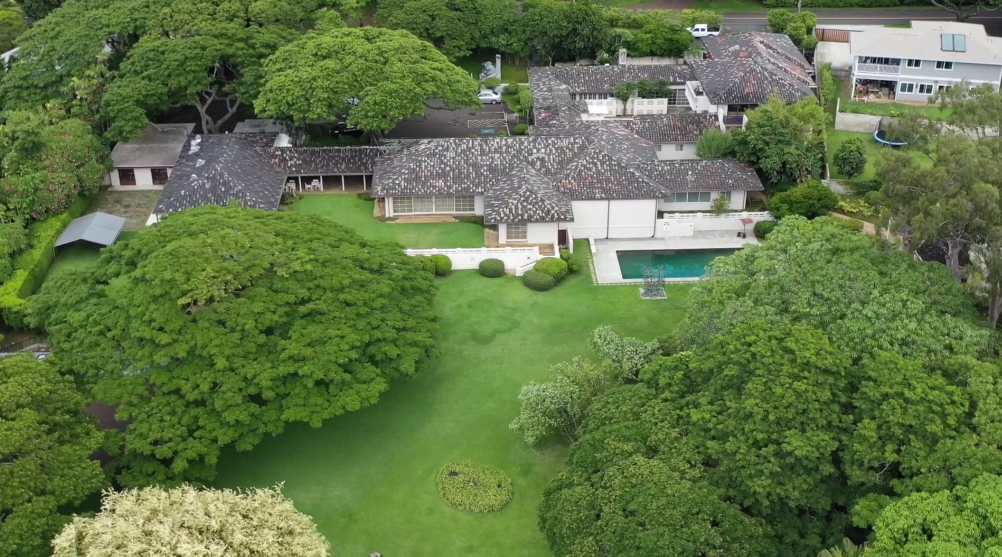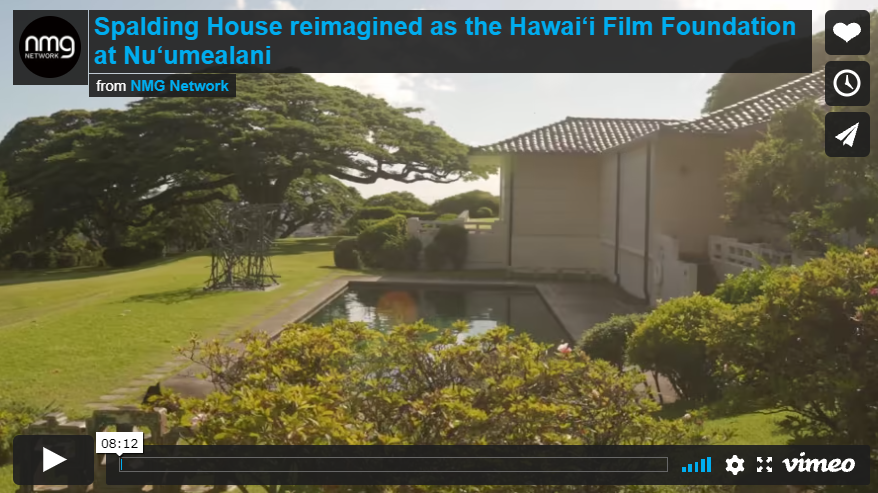A new and networked nonprofit seeks to raise $15 million to buy Spalding House from the Honolulu Museum of Art.
by Chad Blair, Honolulu Civil Beat October 3, 2021 – Republished with permission
It started over a meal at Merriman’s in Honolulu in late January 2020, as things sometimes do.
Meeting a few months after the Honolulu Museum of Art put its historic Spalding House property on the market for $15 million, film festival director Jeannette Paulson Hereniko was introduced to realtor-broker Sarah Bakewell just two months before Covid-19 began to ravage Hawaii.
Hereniko, whose many hats include founding the Hawaii International Film Festival in 1981 and serving as HIFF’s director for the next 15 years, wondered whether Spalding House, nestled in Makiki Heights, could be converted into a hub for local filmmakers rather than sold as a luxury private residence.
“Sarah had an idea of saving Spalding House for the arts, something similar to what she had done for a historical home in St. Louis,” Hereniko said. “I had been looking informally for years up to that point to do something for film, to find a place — a home, a theater where we could show movies. It had been a dream project for years.”
Recalls Bakewell, a Kauai native with Hawaii Life Real Estate Brokers, “When I became aware that it was going to go on the open market, I really felt strongly that it would be great if we could find a group to get together and purchase it and keep it as a community arts asset. Because someone could buy it and make it a home, which of course it was.”

A screen shot from the promotional video for reimagining Spalding House in Makiki Heights.
Bakewell adds, “The more we talked about it, the more it made sense. It would be a fabulous location — a perfect place — for the 10-plus film groups here who have no place to meet.”
That vision turned into the Committee for Saving The Spalding House for the Arts, which soon established the nonprofit Hawaii Film Foundation at Nuumealani.
The foundation’s purpose, as its state registration documents explain, is to provide a place where Hawaii’s nonprofit film organizations, filmmakers and emerging filmmakers can meet to “collaborate, coordinate and create synergy” for local film-related projects that “nurture and build” upon the film industry that is already in Hawaii.
Turning a vision into a reality will not be easy. Honolulu’s housing market is red hot these days, even during a pandemic, and there are many a nonprofit who have seen fundraising efforts take a hit after 18 months of a bleeding local economy.
Seeking a lead donor who would pony up the $1 million calculated as an initial down payment for the purchase, Bakewell says the Hawaii Film Foundation at Nuumealani has yet to find one. Board members have identified about a dozen possible candidates “somehow connected with Hawaii and film and entertainment in spirit,” and Bakewell now says $2 million is likely needed for “a serious purchase.”
But the foundation — Nuumealani translates as “heavenly terrace,” a name once used by the property — has at its advantage the impressive pedigree of Spalding House itself, some very well-connected and well-known backers and a slick 8-minute video pitch.
There is also a well-thought-out 15-page proposal that details the plans, from the legal and governance structure and salaries for a general manager and caretaker ($9,166 each, which includes on-site living space) all the way down to the cost of alert alarms for the facility ($335 a year), gas fees ($200) and landscaping ($8,800).
If the foundation succeeds, the 5,245-square-foot Spalding House, which has a magnificent green lawn that overlooks the city below, would be bought and then gifted by the Honolulu Museum of Art to the Hawaii Film Foundation at Nuumealani, which would preserve the home but also rehabilitate it at an estimated cost of $2 million. Marion Philpotts-Miller of Philpotts Interiors put together the designs.
Once completed, the foundation’s home would provide office space, meeting rooms, classrooms, private screenings, storage, a cafe and community room, an intimate reception area, and exhibit space for on-going interactions and private showings at scheduled times.
A small gift shop will also be on site, and guest residences will be built into the overall plan.
On The Historic Register
Bakewell and Hereniko’s committee has been quietly circulating a short clip to potential donor-buyers that “reimagines” what Spalding House could become.
“Andy Warhol had his factory. Robert Redford had Sundance,” says actor and producer Daniel Dae Kim in the video. “It can’t be overstated to have a place that is a home both physically and emotionally for young filmmakers and young artists, people who want to work on their craft. And I think Spalding House plays a really important role in that because it will serve as a hub.”
Neil Abercrombie, the former Hawaii governor whose wife Nancie Caraway is part of the committee, says, “We’re always looking at just tourism, military spending. We think that we have an opportunity here to make a major worldwide mark through cinema.”
Another featured speaker in the film is Kiersten Faulkner, executive director of the Historic Hawaii Foundation. She explains that Spalding House is on the Hawaii Register of Historic Places for three reasons: It’s significant for its association with people, for broad trends in Hawaii’s history, and for its architecture and design.
Tax credits could be key to making a purchase happen.
“Any work that has the potential to affect the character-defining features must comply with the Secretary of the Interior’s Standards for the Treatment of Historic Properties,” the committee’s proposal says.
Donations to the new 501(c)3 tax-exempt charitable organization — charitable contributions for property acquisition, operations and management, or program development that are “freely given without expectation of anything of value” — may be eligible to receive a 100% IRS tax incentive deduction.

Daniel Dae Kim is one of the featured speakers in the promotional video for Spalding House.
Hereniko and Bakewell are among the founding committee board members. Jeanie Schmaltz, a realtor-broker also with Hawaii Life, is a committee partner and advisor. She and Bakewell are the buyer representatives for the group that are working with the listing agents at Corcoran Pacific Properties in hopes of negotiating a successful sale.
Among the dozen or so nonprofit film organizations participating in the Spalding House project are HIFF, the Hawaii Filmmakers Collective, Hawaii Women in Filmmaking, Pacific Islanders in Communication, the State of Hawaii Creative Lab and the University of Hawaii Manoa Academy of Creative Media.
‘Historical Treasure’
The Honolulu Museum of Art decided to sell Spalding House in the summer of 2019, as The Associated Press reported, to focus on the main campus, which is about 2 miles away on Beretania Street.
The museum’s founder, Anna Rice Cooke, built the house in 1925 as a residential property and named it Nuumealani.
A former Civil Beat columnist, Sterling Higa, wrote in a 2019 column that Rice, born in 1853 to missionary teachers, attended Oahu College (now Punahou School) and married Charles Montague Cooke — the son of a co-founder of Castle & Cooke — in 1874.
“Among other ventures, Charles invested in sugar plantations, supported efforts to have Hawaii annexed by the United States and co-founded Bank of Hawaii. Charles and Anna were among the wealthiest and most influential residents of Hawaii,” Higa wrote.

In 1882, the Cooke family built a home on Beretania Street, just across from Thomas Square, which later became the location of the Honolulu Academy of Arts, renamed the Honolulu Museum of Art in 2012. Cooke’s daughter Alice Spalding took over the Makiki house in 1934 and in 1968 she bequeathed it to the academy.
The property later became the home of newspaper publisher and philanthropist Thurston Twigg-Smith and his family until he donated it to create the Contemporary Museum in 1988. It was gifted back to the arts academy in 2011.
The written proposal from the Spalding House committee describes the property as “a historical and architectural treasure that must be saved as a community asset.”
Bakewell shared with Hereniko her work on the St. Louis project, which sits on 10.5 acres in Kirkwood, Missouri, and is called the Frank Lloyd Wright House in Ebsworth Park. Like Spalding House, the St. Louis home of Russell and Ruth Kraus involved a conditional use permit in a residential neighborhood allowing for controlled, limited access, was accessible to the public and included a nonprofit that solicited donors for its purchase.
Bakewell notes that Spalding House was designed by Hart Wood, an architect known for designing homes for Honolulu’s elite families in the Hawaii regional style that has both Western and Asian influences.

Jeannette Paulson Hereniko in a screen shot from the video. © NMG Network
Now, nearly two years after that meal at Merriman’s, the campaign to save Spalding House is in full swing.
“For us, what’s really important is that after living through the pandemic it’s been really clear that more than ever we need to collaborate, consolidate and create our images, our own stories and work together and cut down the boundaries that have separated us in film organizations,” says Hereniko.
She continued: “I see that we are all doing incredible things to build a film industry based on our own stories and point of view, and also looking equally to Asia and the Pacific. Nuumealani could be a hub, a home, where film organizations can come together and have a place to meet and create and really help our industry grow.”
Republished with permission © Honolulu Civil Beat https://www.civilbeat.org/?p=1461421&utm


